Towards whole-school language curricula. Examples of practice in schools
|

|
The resources provide tools which help to clarify, develop and
implement plurilingual, intercultural and inclusive whole-school
policies in different contexts in ECML member states.
Available in English and German
Go to the publication page
|
502
Towards whole-school language curricula. Examples of practice in schools
The resources provide tools which help to clarify, develop and
implement plurilingual, intercultural and inclusive whole-school
policies in different contexts in ECML member states.
Available in English and German
Go to the publication page
35
//www.ecml.at/Portals/1/mtp4/plurcur/images/PlurCurLogo160.gif
//www.ecml.at/ECML-Programme/Programme2012-2015/PlurCur/tabid/1750/language/en-GB/Default.aspx
7
Incorporating intercultural communicative competence in language teacher education
|

|
The articles in this volume describe the results of the research and development carried out by four networks in Project 1.2.3 of the medium-term programme of activities of the European Centre for Modern Languages in Graz, Austria. The main aim of the whole project has been to help incorporate intercultural communication training into teacher education in Europe. The networks took on a variety of tasks to investigate how this aim could be best achieved.
Available in English and French.
Go to the publication page
Go to the website
|
75
Incorporating intercultural communicative competence in language teacher education
The articles in this volume describe the results of the research and development carried out by four networks in Project 1.2.3 of the medium-term programme of activities of the European Centre for Modern Languages in Graz, Austria. The main aim of the whole project has been to help incorporate intercultural communication training into teacher education in Europe. The networks took on a variety of tasks to investigate how this aim could be best achieved.
Available in English and French.
Go to the publication page
Go to the website
26
//www.ecml.at/Portals/1/ECML.Publications.Files/21c6528d-99c4-4fbe-9f7a-ad518a4a68ec.jpg
7
Mirrors and Windows: An intercultural communication textbook
|

|
Intercultural experiences pose inevitable challenges to one´s personal identity and communication skills. One has to learn how to deal with unexpectedness, ambiguity and otherness as well as the resulting culture bumps or culture shock. The knowledge, skills and attitudes that are necessary for successful intercultural communication have to be observed, discussed and practiced. This textbook wishes to help the trainer, the teacher and the learner in this process by encouraging culture-general discussions about culture with a small "c" and by using a reflective approach.
Available in English, French and German.
Go to the publication page |
49
Mirrors and Windows: An intercultural communication textbook
Intercultural experiences pose inevitable challenges to one´s personal identity and communication skills. One has to learn how to deal with unexpectedness, ambiguity and otherness as well as the resulting culture bumps or culture shock. The knowledge, skills and attitudes that are necessary for successful intercultural communication have to be observed, discussed and practiced. This textbook wishes to help the trainer, the teacher and the learner in this process by encouraging culture-general discussions about culture with a small "c" and by using a reflective approach.
Available in English, French and German.
Go to the publication page
25
//www.ecml.at/Portals/1/ECML.Publications.Files/bcddf65e-d6de-485a-89b6-abdc206461d2.jpg
//www.ecml.at/tabid/277/PublicationID/43/Default.aspx
7
ICOPROMO – Intercultural competence for professional mobility
|

|
This publication reflects the outcomes of a project which brought together experts and practitioners in the field of intercultural competence for professional mobility and which focused on group-oriented (teamwork) intercultural communication and interaction competencies. The materials developed are primarily targeted at educators and facilitators working with graduates in the social sciences, human resource managers, intercultural trainers,coaches and mediators and foreign language teachers in higher education with a strong focus on intercultural awareness.
Available in English and French.
Go to the publication page |
44
ICOPROMO – Intercultural competence for professional mobility
This publication reflects the outcomes of a project which brought together experts and practitioners in the field of intercultural competence for professional mobility and which focused on group-oriented (teamwork) intercultural communication and interaction competencies. The materials developed are primarily targeted at educators and facilitators working with graduates in the social sciences, human resource managers, intercultural trainers,coaches and mediators and foreign language teachers in higher education with a strong focus on intercultural awareness.
Available in English and French.
Go to the publication page
23
//www.ecml.at/Portals/1/ECML.Publications.Files/98370716-b111-4c0b-a7de-b13c34f9e8cd.jpg
//www.ecml.at/tabid/277/PublicationID/20/Default.aspx
7
ENSEMBLE – Promoting linguistic diversity and whole-school development
|

|
The Council of Europe stresses the importance of societal multilingualism and of individual plurilingual competence as means to social cohesion. Why this is important and how it can be achieved are explained in the Language Policy Unit document “Guide for the Development of Language Education Policies in Europe”. Ultimately, it is within the school, at the chalk face, that the necessary innovations need to take place. The case studies presented in this publication are an authentic illustration of how this is being realised in different contexts; and what successes and challenges it presents.
Available in English and French.
Go to the publication page |
54
ENSEMBLE – Promoting linguistic diversity and whole-school development
The Council of Europe stresses the importance of societal multilingualism and of individual plurilingual competence as means to social cohesion. Why this is important and how it can be achieved are explained in the Language Policy Unit document “Guide for the Development of Language Education Policies in Europe”. Ultimately, it is within the school, at the chalk face, that the necessary innovations need to take place. The case studies presented in this publication are an authentic illustration of how this is being realised in different contexts; and what successes and challenges it presents.
Available in English and French.
Go to the publication page
21
//www.ecml.at/Portals/1/ECML.Publications.Files/e00d720a-7bc6-4aaa-b984-7483c2c37e48.jpg
//www.ecml.at/Resources/ECMLPublications/tabid/277/PublicationID/9/language/en-GB/Default.aspx
7
The Plurilingualism Project: Tertiary Language Learning - German after English
|

|
If the peoples of Europe are to live in harmony with their neighbours, if they are to communicate with and understand each other, the command of more than only one foreign language will be an increasingly important factor. For this reason both the Council of Europe and the European Union are demanding that their citizens should learn two foreign l anguages alongside their mother tongues. The Year of Languages 2001 was the stimulus for an investigation into how concepts of teaching and learning several languages could be developed and put into practice.
Available in English, French and German.
Go to the publication page |
167
The Plurilingualism Project: Tertiary Language Learning - German after English
If the peoples of Europe are to live in harmony with their neighbours, if they are to communicate with and understand each other, the command of more than only one foreign language will be an increasingly important factor. For this reason both the Council of Europe and the European Union are demanding that their citizens should learn two foreign l anguages alongside their mother tongues. The Year of Languages 2001 was the stimulus for an investigation into how concepts of teaching and learning several languages could be developed and put into practice.
Available in English, French and German.
Go to the publication page
20
//www.ecml.at/Portals/1/ECML.Publications.Files/e585b3df-51f7-46ab-bb40-b8b1f2c5ab79.jpg
7
Cultural awareness and language awareness based on dialogic interaction with texts in foreign language learning
|

|
The purpose of this book is not to give recipes. It is an attempt to investigate, theoretically as well as practically, certain important concepts in foreign language learning: dialogue, communication, intercultural awareness, language awareness, and the roles of teacher and learner.
Available in English and French.
Go to the publication page
|
181
Cultural awareness and language awareness based on dialogic interaction with texts in foreign language learning
The purpose of this book is not to give recipes. It is an attempt to investigate, theoretically as well as practically, certain important concepts in foreign language learning: dialogue, communication, intercultural awareness, language awareness, and the roles of teacher and learner.
Available in English and French.
Go to the publication page
18
//www.ecml.at/Portals/1/ECML.Publications.Files/3f9e4a5f-b5e9-417b-9724-4633152ff7d3.jpg
7
Collaborative Community Approach to Migrant Education. A virtual open course for educators
|

|
The resources offer innovative ways to enhance young
migrants’ education by developing links between schools,
the home and local partners in education. This educational
joint venture develops the learners’ skills in the language of
schooling as well as their plurilingual competences.
Available in EN and FR
Go to the publication page |
496
Collaborative Community Approach to Migrant Education. A virtual open course for educators
The resources offer innovative ways to enhance young
migrants’ education by developing links between schools,
the home and local partners in education. This educational
joint venture develops the learners’ skills in the language of
schooling as well as their plurilingual competences.
Available in EN and FR
Go to the publication page
11
//www.ecml.at/Portals/1/images/logos/Logo%20Educo%20migrant.jpg
//www.ecml.at/ECML-Programme/Programme2012-2015/Community/tabid/1836/Default.aspx
7
Teaching the language of schooling in the context of diversity. Study materials for teacher development
|
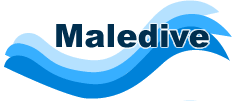
|
The study materials focus on teacher education for the
language of schooling (e.g. French in France, Polish in
Poland). They draw on the linguistic and cultural diversity in
the classroom for the benefit of all learners.
Available in English, French and German
Go to the publication page |
499
Teaching the language of schooling in the context of diversity. Study materials for teacher development
The study materials focus on teacher education for the
language of schooling (e.g. French in France, Polish in
Poland). They draw on the linguistic and cultural diversity in
the classroom for the benefit of all learners.
Available in English, French and German
Go to the publication page
9
//www.ecml.at/Portals/1/mtp4/maledive/images/logo-maledive.gif
http://maledive.ecml.at/Home/tabid/3598/language/en-GB/Default.aspx
7
European portfolio for pre-primary educators. The plurilingual and intercultural dimension
|
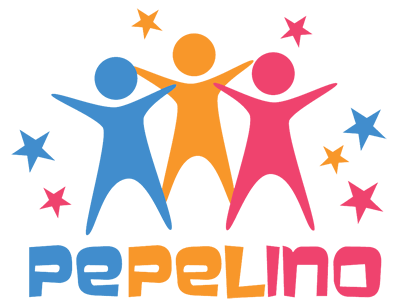
|
This portfolio is designed for educators and teachers in the pre-primary sector, either in initial or in-service training. It encourages personal reflection on the professional skills related to the linguistic and intercultural dimension of working with children.
Available in English and French
Go to the publication page |
501
European portfolio for pre-primary educators. The plurilingual and intercultural dimension
This portfolio is designed for educators and teachers in the pre-primary sector, either in initial or in-service training. It encourages personal reflection on the professional skills related to the linguistic and intercultural dimension of working with children.
Available in English and French
Go to the publication page
7
//www.ecml.at/Portals/1/mtp4/preelementaire/images/pepelino-logo.gif
//www.ecml.at/ECML-Programme/Programme2012-2015/Pepelino/tabid/1833/language/en-GB/Default.aspx
7
CARAP/FREPA – A Framework of Reference for Pluralistic Approaches
|

|
The term pluralistic approaches to languages and cultures refers to didactic approaches which involve the use of several (or at least more than one) variety of languages or cultures simultaneously during the teaching process. By abandoning the "compartmentalised" view of an individual’s linguistic and cultural competence(s), this publication is a valuable step towards implementing the Common European Framework of Reference for Languages, in particular its rationale on plurilingual and intercultural competence.
Available in English, French and Italian.
Go to the publication page
Go to the project page |
39
CARAP/FREPA – A Framework of Reference for Pluralistic Approaches
The term pluralistic approaches to languages and cultures refers to didactic approaches which involve the use of several (or at least more than one) variety of languages or cultures simultaneously during the teaching process. By abandoning the "compartmentalised" view of an individual’s linguistic and cultural competence(s), this publication is a valuable step towards implementing the Common European Framework of Reference for Languages, in particular its rationale on plurilingual and intercultural competence.
Available in English, French and Italian.
Go to the publication page
Go to the project page
6
//www.ecml.at/Portals/1/ECML.Publications.Files/e9537c07-19e6-410e-8be4-d0d683416076.jpg
//www.ecml.at/tabid/277/PublicationID/82/Default.aspx
7
CONBAT – Plurilingualism and pluriculturalism in content-based teaching: A training kit
|

|
Educational institutions increasingly face the challenge of accommodating learners from a wide range of linguistic and cultural backgrounds in their classrooms. The training kit presents an innovative way of managing diversity in the classroom by combining plurilingual and pluricultural approaches with content-based instruction. The reader will discover how content-based and plurilingual activities can be linked to several subjects of the curriculum.
Available in English and French.
Go to the publication page
Go to the project page |
52
CONBAT – Plurilingualism and pluriculturalism in content-based teaching: A training kit
Educational institutions increasingly face the challenge of accommodating learners from a wide range of linguistic and cultural backgrounds in their classrooms. The training kit presents an innovative way of managing diversity in the classroom by combining plurilingual and pluricultural approaches with content-based instruction. The reader will discover how content-based and plurilingual activities can be linked to several subjects of the curriculum.
Available in English and French.
Go to the publication page
Go to the project page
4
//www.ecml.at/Portals/1/ECML.Publications.Files/3ab0fb61-119b-4cb1-8f8c-6be3930edf9d.jpg
//www.ecml.at/tabid/277/PublicationID/69/Default.aspx
7
PARENTS ‒ Involving parents in plurilingual and intercultural education
|

|
This project aims at disseminating knowledge on the benefits of involving parents in plurilingual and intercultural education. Working with parents as partners facilitates not only language acquisition, but also the development of positive attitudes towards otherness, attitudes which are necessary for the harmonious development of individuals and society. The dissemination of information and knowledge on such practices will contribute to overcome fears relative to the inclusion of parents in school activities. Descriptions of plurilingual and intercultural activities will be offered, so as to provide parents and teachers with tools that will help them to work together in plurilingual and intercultural education. Go to the project page |
305
PARENTS ‒ Involving parents in plurilingual and intercultural education
This project aims at disseminating knowledge on the benefits of involving parents in plurilingual and intercultural education. Working with parents as partners facilitates not only language acquisition, but also the development of positive attitudes towards otherness, attitudes which are necessary for the harmonious development of individuals and society. The dissemination of information and knowledge on such practices will contribute to overcome fears relative to the inclusion of parents in school activities. Descriptions of plurilingual and intercultural activities will be offered, so as to provide parents and teachers with tools that will help them to work together in plurilingual and intercultural education.
Go to the project page
4
//www.ecml.at/Portals/1/images/logos/Parents%20logo.jpg
7
MARILLE – Promoting plurilingualism: majority language in multilingual settings
|

|
Traditionally, teachers of majority languages receive less training to teach a language as a second language or to develop the plurilingual repertoire of their learners than, for example, foreign language teachers.Yet, in today’s societies, learners bring many different languages to school.This means that the teaching of themajority language has to extend beyond teaching it as a first language and adopt elements of second language teaching.
Available in English and German.
Go to the publication page
Go to the project page |
55
MARILLE – Promoting plurilingualism: majority language in multilingual settings
Traditionally, teachers of majority languages receive less training to teach a language as a second language or to develop the plurilingual repertoire of their learners than, for example, foreign language teachers.Yet, in today’s societies, learners bring many different languages to school.This means that the teaching of themajority language has to extend beyond teaching it as a first language and adopt elements of second language teaching.
Available in English and German.
Go to the publication page
Go to the project page
3
//www.ecml.at/Portals/1/ECML.Publications.Files/f357c600-ab7c-457a-9363-b2feda52d4bb.jpg
//www.ecml.at/tabid/277/PublicationID/75/Default.aspx
7
ICCinTE – Intercultural Communication Training in Teacher Education
|

|
Many language teachers, teacher educators and second language acquisition researchers have expressed the conviction that the primary aim of foreign language teaching is to enable learners to communicate with people from different linguistic and cultural backgrounds in an increasingly multicultural world. The aim of this publication is to assist teacher educators and language teachers in shifting the focus from linguistic competence to intercultural communicative competence.
Available in English and French.
Download the publication |
32
ICCinTE – Intercultural Communication Training in Teacher Education
Many language teachers, teacher educators and second language acquisition researchers have expressed the conviction that the primary aim of foreign language teaching is to enable learners to communicate with people from different linguistic and cultural backgrounds in an increasingly multicultural world. The aim of this publication is to assist teacher educators and language teachers in shifting the focus from linguistic competence to intercultural communicative competence.
Available in English and French.
Download the publication
3
//www.ecml.at/Portals/1/ECML.Publications.Files/1779929d-9817-4f24-ae28-9ec11f3abca3.jpg
//www.ecml.at/Resources/ECMLPublications/tabid/277/PublicationID/22/language/en-GB/Default.aspx
7
VALEUR ‒ Valuing all languages in Europe
|

|
The aim of the Valeur was to raise awareness of the “additional” languages – those which are not national and regional languages – used in Europe, and collate information about the educational provision made for them. A flyer describes the educational, social and cognitive benefits of plurilingualism and a report includes country by country details of the languages in use, together with recommendations on educational policies to deal with the issues arising from linguistic diversity.
Available in English, French and Hungarian.
Download the publication |
62
VALEUR ‒ Valuing all languages in Europe
The aim of the Valeur was to raise awareness of the “additional” languages – those which are not national and regional languages – used in Europe, and collate information about the educational provision made for them. A flyer describes the educational, social and cognitive benefits of plurilingualism and a report includes country by country details of the languages in use, together with recommendations on educational policies to deal with the issues arising from linguistic diversity.
Available in English, French and Hungarian.
Download the publication
2
//www.ecml.at/Portals/1/ECML.Publications.Files/de61aa6a-5254-4902-b9f4-a3c3ae0e104c.jpg
7
Plurimobil ‒ Mobility for plurilingual and intercultural education: Tools for language teachers and teacher trainers
|
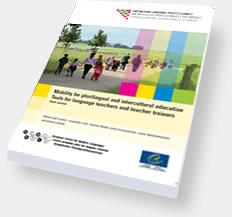
|
The aim of the PluriMobil project is to present a pedagogical device which will enable teachers to assist learners in benefiting, as much as possible, from the learning opportunities which they are offered by mobility – by integrating their intercultural and plurilingual encounters in a sustained learning process.
Go to the project page Download the draft publication
|
269
Plurimobil ‒ Mobility for plurilingual and intercultural education: Tools for language teachers and teacher trainers
The aim of the PluriMobil project is to present a pedagogical device which will enable teachers to assist learners in benefiting, as much as possible, from the learning opportunities which they are offered by mobility – by integrating their intercultural and plurilingual encounters in a sustained learning process.
Go to the project page
Download the draft publication
2
https://plurimobil.ecml.at/Portals/banners/book-plurimobil-grey.jpg
7
EBP-ICI – Regional/Minority Languages in bi-/plurilingual education: Languages from near and far
|

|
Based on European objectives to favour linguistic diversity and plurilingual and pluricultural education, the publication presents pilotedmaterials, activities and didactic tools. These are related to a theoretical framework which creates links between dominant languages and minority or regional languages in Europe and beyond. A teaching kit also offers a collection of practical examples and recommendations for policy-makers in the area of education.
Available in English and French.
Go to the publication page
Go to the project page |
186
EBP-ICI – Regional/Minority Languages in bi-/plurilingual education: Languages from near and far
Based on European objectives to favour linguistic diversity and plurilingual and pluricultural education, the publication presents pilotedmaterials, activities and didactic tools. These are related to a theoretical framework which creates links between dominant languages and minority or regional languages in Europe and beyond. A teaching kit also offers a collection of practical examples and recommendations for policy-makers in the area of education.
Available in English and French.
Go to the publication page
Go to the project page
1
//www.ecml.at/Portals/1/ECML.Publications.Files/87deeea7-8c08-44a2-b3d1-5bcbbb578962.jpg
7
Together in Europe in the 21st century: The challenge of plurilingual and multicultural communication and dialogue
|

|
The third colloquy of the European Centre for Modern Languages (ECML) was
attended by experts from more than thirty countries. The ambitious theme - “Living together in Europe in the 21st century: the challenge of plurilingual and multicultural
communication and dialogue” - held considerable significance for the future of languages in Europe.
Available in English and French.
Go to the publication page |
190
Together in Europe in the 21st century: The challenge of plurilingual and multicultural communication and dialogue
The third colloquy of the European Centre for Modern Languages (ECML) was
attended by experts from more than thirty countries. The ambitious theme - “Living together in Europe in the 21st century: the challenge of plurilingual and multicultural
communication and dialogue” - held considerable significance for the future of languages in Europe.
Available in English and French.
Go to the publication page
1
//www.ecml.at/Portals/1/ECML.Publications.Files/ed60aea5-b2cf-49e2-a58b-59e3b70e816f.gif
7
The organisation of language education in small states
|

|
The experiences of small States in the area of the organization and set-up of language education may in certain respects differ substantially from the experiences of larger states. Considering the importance that is attributed, on a European scale, of linguistic and cultural diversity, to the promotion of education for plurilingualism in general, and to the promotion of diversification in language teaching, especially for lesser used languages, experiences of these countries are of particular interest. It has been demonstrated that through choice or necessity plurilingualism constitutes one of their major assets.
Available in English and French.
Go to the publication page |
53
The organisation of language education in small states
The experiences of small States in the area of the organization and set-up of language education may in certain respects differ substantially from the experiences of larger states. Considering the importance that is attributed, on a European scale, of linguistic and cultural diversity, to the promotion of education for plurilingualism in general, and to the promotion of diversification in language teaching, especially for lesser used languages, experiences of these countries are of particular interest. It has been demonstrated that through choice or necessity plurilingualism constitutes one of their major assets.
Available in English and French.
Go to the publication page
1
//www.ecml.at/Portals/1/ECML.Publications.Files/ea2db1f9-281b-40b0-8d86-71d3cc48bdd7.jpg
//www.ecml.at/tabid/277/PublicationID/27/Default.aspx
7
Cultural mediation and language learning and teaching
|

|
This training project for learning about research through research brought together representatives from over twenty-five of the ECML member countries. Its results are contained in a publication and a set of recommendations addressed to policy makers, is the introduction of cultural mediation into the debate on language didactics. Whereas most innovations in language didactics appear in the form of new teaching tools, the Cultural mediation in language learning and teaching project chose to follow a new path by adopting a "learning by doing" approach to research.
Available in English and French.
Go to the publication page |
40
Cultural mediation and language learning and teaching
This training project for learning about research through research brought together representatives from over twenty-five of the ECML member countries. Its results are contained in a publication and a set of recommendations addressed to policy makers, is the introduction of cultural mediation into the debate on language didactics. Whereas most innovations in language didactics appear in the form of new teaching tools, the Cultural mediation in language learning and teaching project chose to follow a new path by adopting a "learning by doing" approach to research.
Available in English and French.
Go to the publication page
1
//www.ecml.at/Portals/1/ECML.Publications.Files/7b89a1ed-c3ef-425f-ae9a-7a6b48ce6848.jpg
//www.ecml.at/tabid/277/PublicationID/42/Default.aspx
7
How strange! The use of anecdotes in the development of intercultural competence
|

|
Successful communication presupposes a good degree of social understanding and sharing of meaning and therefore participating in a community's life via another language necessitates not only an acceptable level of proficiency in that language, but also an extended behavioural code. What kind of cultural set-backs do language learners face when visiting the target country, or even in interacting with native speakers of a language? What can we learn from the experience of such learners? The aim of this project was to tap into the experiences of seasoned foreign language learners and travellers for the collection of a database of anecdotes that symbolise the kind of intercultural failure faced by newcomers to a target culture.
Available in English and French.
Go to the publication page |
43
How strange! The use of anecdotes in the development of intercultural competence
Successful communication presupposes a good degree of social understanding and sharing of meaning and therefore participating in a community's life via another language necessitates not only an acceptable level of proficiency in that language, but also an extended behavioural code. What kind of cultural set-backs do language learners face when visiting the target country, or even in interacting with native speakers of a language? What can we learn from the experience of such learners? The aim of this project was to tap into the experiences of seasoned foreign language learners and travellers for the collection of a database of anecdotes that symbolise the kind of intercultural failure faced by newcomers to a target culture.
Available in English and French.
Go to the publication page
1
//www.ecml.at/Portals/1/ECML.Publications.Files/262c6213-2e44-4a1a-8c00-c11823ef0858.jpg
//www.ecml.at/tabid/277/PublicationID/36/Default.aspx
7
Neighbouring language teaching in border regions
|

|
Europe is rapidly developing, particularly in its border regions. It is precisely in these areas that the need for knowledge of neighbouring languages is both at its strongest and most varied. Approaches adapted to their specific situation are required in order for these regions to quickly become real-life language learning laboratories and centres of innovation.
Available in English.
Go to the publication page |
50
Neighbouring language teaching in border regions
Europe is rapidly developing, particularly in its border regions. It is precisely in these areas that the need for knowledge of neighbouring languages is both at its strongest and most varied. Approaches adapted to their specific situation are required in order for these regions to quickly become real-life language learning laboratories and centres of innovation.
Available in English.
Go to the publication page
1
//www.ecml.at/Portals/1/ECML.Publications.Files/9aeff5eb-1720-46bc-a71b-dea65fab99c8.jpg
//www.ecml.at/tabid/277/PublicationID/28/Default.aspx
7
Languages for social cohesion: Language education in a multilingual and multicultural Europe
|

|
The ECML’s “Languages for social cohesion” programme (2004-2007) involved approximately 4500 language professionals from Europe and beyond. This publication focuses on key developments in language education promoted through the work of the European Centre for Modern Languages of the Council of Europe (ECML).
Available in English and French.
Go to the publication page |
17
Languages for social cohesion: Language education in a multilingual and multicultural Europe
The ECML’s “Languages for social cohesion” programme (2004-2007) involved approximately 4500 language professionals from Europe and beyond. This publication focuses on key developments in language education promoted through the work of the European Centre for Modern Languages of the Council of Europe (ECML).
Available in English and French.
Go to the publication page
1
//www.ecml.at/Portals/1/ECML.Publications.Files/d4b6263e-6518-4cb3-84ec-bbf24f65d226.gif
//www.ecml.at/tabid/277/PublicationID/57/Default.aspx
7
ALC – Across languages and cultures
|

|
Across languages and cultures – a major theoretical framework for plural approaches to learning languages and cultures – language learning in which more than one language (in addition to the learner’s first language) is involved. The Framework explains the conceptual justification for the approach, and includes descriptors of the knowledge, skills and attitudes required to implement didactic approaches to it – awakening to languages, inter-comprehension and integrated didactics.
Available in English, French, German and Hungarian.
Go to the publication page |
37
ALC – Across languages and cultures
Across languages and cultures – a major theoretical framework for plural approaches to learning languages and cultures – language learning in which more than one language (in addition to the learner’s first language) is involved. The Framework explains the conceptual justification for the approach, and includes descriptors of the knowledge, skills and attitudes required to implement didactic approaches to it – awakening to languages, inter-comprehension and integrated didactics.
Available in English, French, German and Hungarian.
Go to the publication page
1
//www.ecml.at/Portals/1/ECML.Publications.Files/a21e3139-77d4-401c-9f49-a6ecbda11c45.jpg
//www.ecml.at/Resources/ECMLPublications/tabid/277/PublicationID/15/language/en-GB/Default.aspx
7
Janua Linguarum – the gateway to languages. The introduction of language awareness into the curriculum: Awakening to languages
|

|
Discovering at school the diversity of languages and cultures, listening to dozens of languages, including some of the languages spoken by classmates, marveling at the way those languages are written, comparing them and understanding how they work, taking an interest in those who speak them. These are the types of activities that the awakening to languages offers pupils; to help them open up to what is different, and develop their ability to observe and learn languages. This approach is an integral part of efforts by the Council of Europe aimed at plurilinguism, promoting the diversity of languages in education systems and democratic citizenship.
Available in English and French.
Go to the publication page |
45
Janua Linguarum – the gateway to languages. The introduction of language awareness into the curriculum: Awakening to languages
Discovering at school the diversity of languages and cultures, listening to dozens of languages, including some of the languages spoken by classmates, marveling at the way those languages are written, comparing them and understanding how they work, taking an interest in those who speak them. These are the types of activities that the awakening to languages offers pupils; to help them open up to what is different, and develop their ability to observe and learn languages. This approach is an integral part of efforts by the Council of Europe aimed at plurilinguism, promoting the diversity of languages in education systems and democratic citizenship.
Available in English and French.
Go to the publication page
1
//www.ecml.at/Portals/1/ECML.Publications.Files/2d466d1a-312c-4ec0-971f-7543484ee315.jpg
//www.ecml.at/tabid/277/PublicationID/31/Default.aspx
7
Language learning and teaching in the context of twin cities
|

|
The twinning of cities and municipalities possibly represents the largest platform for encounter and mutual acquaintance established in modern times. However, can such a merger between the fellow-citizens of Europe be achieved without first addressing in a determined way the issue of languages, of teaching languages and their diversity? Answers to this question can be found before, during and after visits to participating towns. School exchange programmes also deserve a better preparation and a genuine teaching methodology for exchanges.
Available in English and French.
Go to the publication page |
46
Language learning and teaching in the context of twin cities
The twinning of cities and municipalities possibly represents the largest platform for encounter and mutual acquaintance established in modern times. However, can such a merger between the fellow-citizens of Europe be achieved without first addressing in a determined way the issue of languages, of teaching languages and their diversity? Answers to this question can be found before, during and after visits to participating towns. School exchange programmes also deserve a better preparation and a genuine teaching methodology for exchanges.
Available in English and French.
Go to the publication page
1
//www.ecml.at/Portals/1/ECML.Publications.Files/c47f67f4-2294-4e08-9184-7d04a6810b71.jpg
//www.ecml.at/tabid/277/PublicationID/30/Default.aspx
7
Literacy as correspondence – an integrated approach to multi-literacy
|

|
This collection of case studies offers the reader different but equally important perspectives to be considered in teaching second or subsequent literacies to relatively young learners. It is important to examine what and how teachers present learning material to the students. However, what learners make of the teaching context and how the formal situation prepares children to make use of their second/subsequent literacy achievement beyond the classroom context are crucial issues if language learning is indeed a requirement which fosters communication among different communities and cultures.
Available in English and French.
Go to the publication page |
47
Literacy as correspondence – an integrated approach to multi-literacy
This collection of case studies offers the reader different but equally important perspectives to be considered in teaching second or subsequent literacies to relatively young learners. It is important to examine what and how teachers present learning material to the students. However, what learners make of the teaching context and how the formal situation prepares children to make use of their second/subsequent literacy achievement beyond the classroom context are crucial issues if language learning is indeed a requirement which fosters communication among different communities and cultures.
Available in English and French.
Go to the publication page
1
//www.ecml.at/Portals/1/ECML.Publications.Files/1a253387-9cf4-4ae0-8460-ceaf839a0c2b.jpg
//www.ecml.at/tabid/277/PublicationID/29/Default.aspx
7
LEA ‒ Plurilingual and pluricultural awareness in language teacher education: A training kit
|

|
The LEA (Language Educator Awareness) training kit comprises a set of practical instruments designed to help teacher educators introduce the essential aspects of plurilingualism and pluriculturalism to language teachers and learners. It consists of a printed booklet setting out the rationale for a series of training activities, which are contained on an accompanying CD-Rom.
Available in English and French.
Go to the publication page |
33
LEA ‒ Plurilingual and pluricultural awareness in language teacher education: A training kit
The LEA (Language Educator Awareness) training kit comprises a set of practical instruments designed to help teacher educators introduce the essential aspects of plurilingualism and pluriculturalism to language teachers and learners. It consists of a printed booklet setting out the rationale for a series of training activities, which are contained on an accompanying CD-Rom.
Available in English and French.
Go to the publication page
0
//www.ecml.at/Portals/1/ECML.Publications.Files/6bdda718-25b6-4280-9efe-b21836da4342.jpg
//www.ecml.at/Resources/ECMLPublications/tabid/277/PublicationID/21/language/en-EN/Default.aspx
7
Learning environments where modern languages flourish (ongoing project)
|
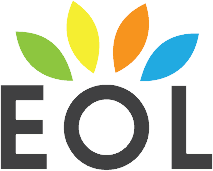
|
The project ‘Fostering learning environments where modern languages flourish’ (EOL) aims to place languages right at the heart of education policy developments. It seeks through (and for) languages to strengthen the development both of social competences and competences for democratic citizenship.
Go to the project page |
1639
Learning environments where modern languages flourish (ongoing project)
The project ‘Fostering learning environments where modern languages flourish’ (EOL) aims to place languages right at the heart of education policy developments. It seeks through (and for) languages to strengthen the development both of social competences and competences for democratic citizenship.
Go to the project page
0
https://www.ecml.at/Portals/1/5MTP/images/logo-flourish-EOL.gif
7
CHAGAL - Setup
|
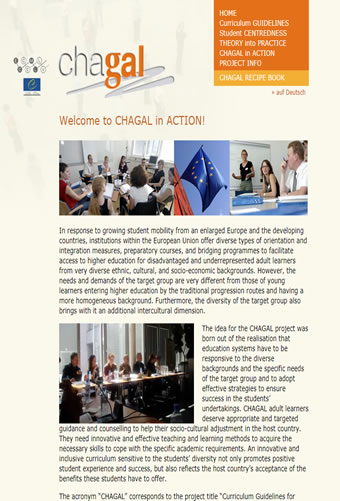
|
The idea for the CHAGAL project was born out of the realisation that education systems have to be responsive to the diverse backgrounds and specific needs of international students and to adopt effective strategies to offer students every chance of success in their undertakings. An innovative and inclusive curriculum sensitive to the students’ diversity not only promotes positive student reaction and success, but also reflects the host country’s acceptance of the potential these students have to offer.
Available in English and German
Go to the publication page |
1721
CHAGAL - Setup
The idea for the CHAGAL project was born out of the realisation that education systems have to be responsive to the diverse backgrounds and specific needs of international students and to adopt effective strategies to offer students every chance of success in their undertakings. An innovative and inclusive curriculum sensitive to the students’ diversity not only promotes positive student reaction and success, but also reflects the host country’s acceptance of the potential these students have to offer.
Available in English and German
Go to the publication page
0
https://www.ecml.at/Portals/1/images/covers/chagal.jpg?ver=2018-04-03-114355-390
7
Gulliver – To get to know each other leads to better mutual understanding
|
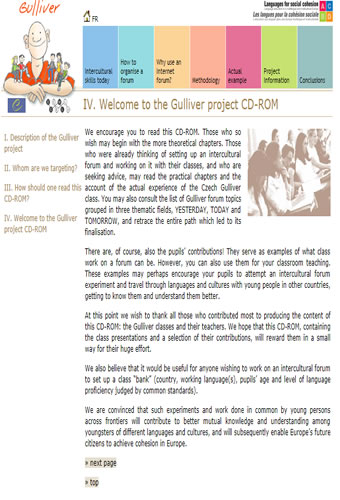
|
This CD-Rom examines the place of intercultural competence in the language classroom, based on the example of the “Gulliver” Internet forum, with contributors from 23 classes in 22 different European countries. The impetus for the Gulliver project was the realisation that there will never be a truly united Europe without better mutual knowledge and understanding among its citizens.
Available in English and French
Go to the publication page
|
1726
Gulliver – To get to know each other leads to better mutual understanding
This CD-Rom examines the place of intercultural competence in the language classroom, based on the example of the “Gulliver” Internet forum, with contributors from 23 classes in 22 different European countries. The impetus for the Gulliver project was the realisation that there will never be a truly united Europe without better mutual knowledge and understanding among its citizens.
Available in English and French
Go to the publication page
0
https://www.ecml.at/Portals/1/images/covers/Gulliver-Project.jpg?ver=2018-03-22-170401-387
7
Language across the curriculum: Network processing and material production in an international context
|
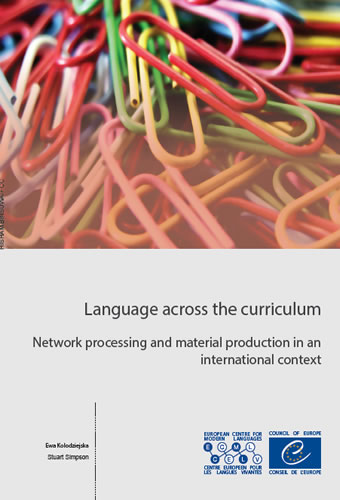
|
Language Across the Curriculum LAC, was one of four international networks set up at the ECML Workshop No. 4/97, held in Poland, entitled 'Foreign language teaching and learning in Central and Eastern Europe: Towards common principles for European foreign language curricula for children of age 9-11'. LAC represents an exciting new approach to foreign language learning at the primary and secondary level, whereby children learn a language simultaneously with other practical exercises i.e. learning a short song in a foreign language.
Available in English and French
Go to the publication page |
1729
Language across the curriculum: Network processing and material production in an international context
Language Across the Curriculum LAC, was one of four international networks set up at the ECML Workshop No. 4/97, held in Poland, entitled 'Foreign language teaching and learning in Central and Eastern Europe: Towards common principles for European foreign language curricula for children of age 9-11'. LAC represents an exciting new approach to foreign language learning at the primary and secondary level, whereby children learn a language simultaneously with other practical exercises i.e. learning a short song in a foreign language.
Available in English and French
Go to the publication page
0
https://www.ecml.at/Portals/1/images/covers/Language-across-the-curriculum-Network-processing-and-material-production-in-an-international-context.pdf.jpg?ver=2018-06-04-103312-510
7